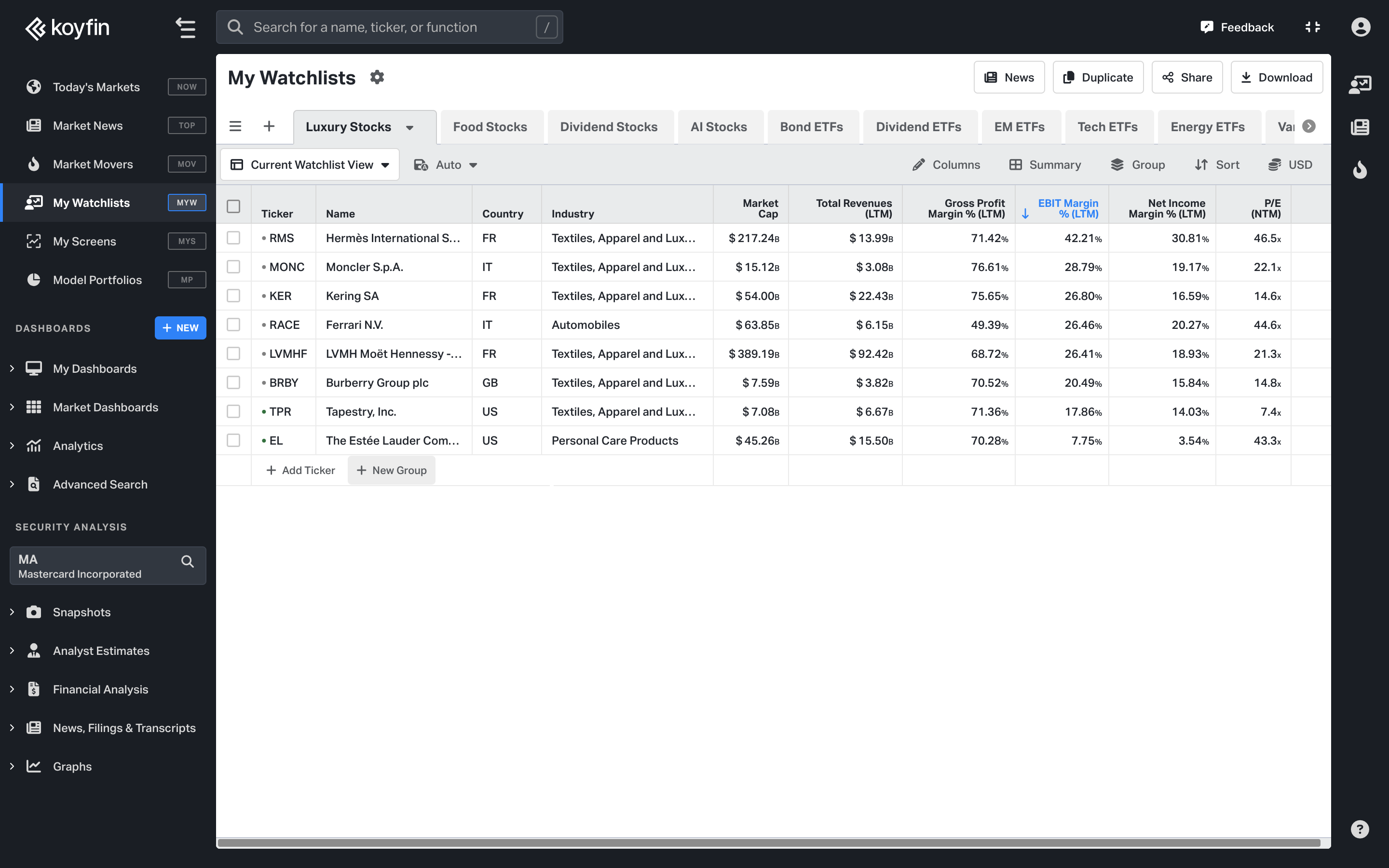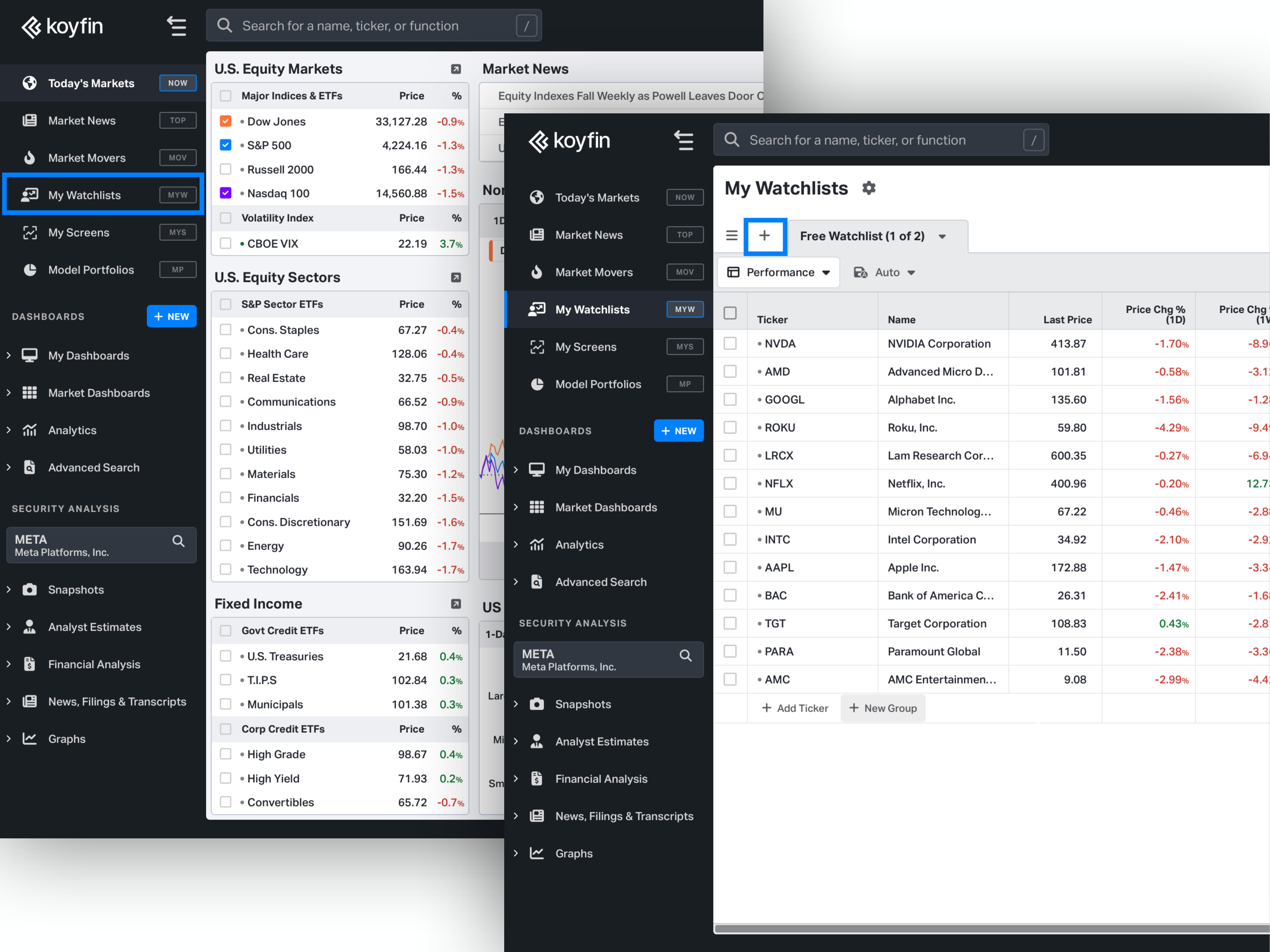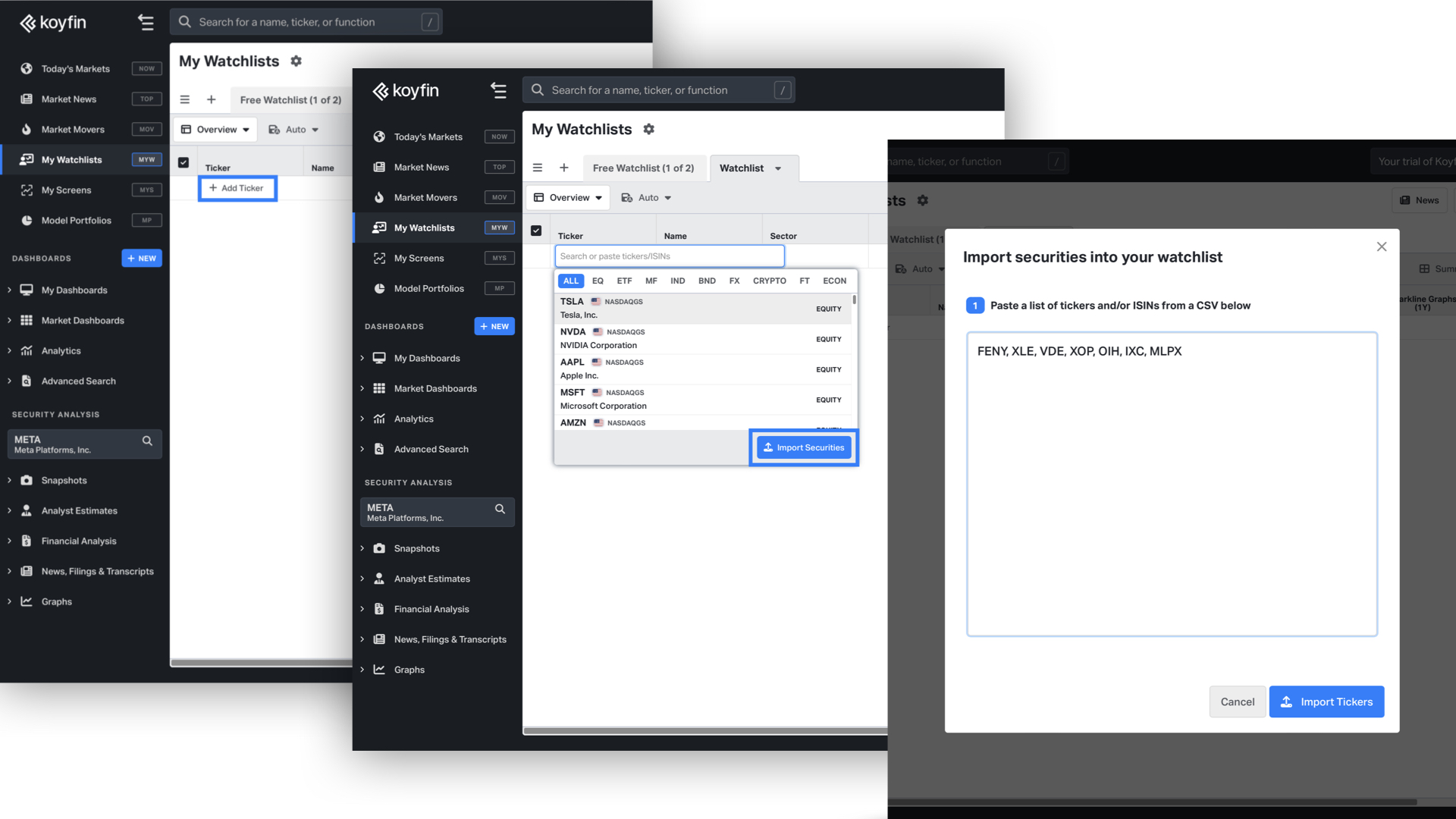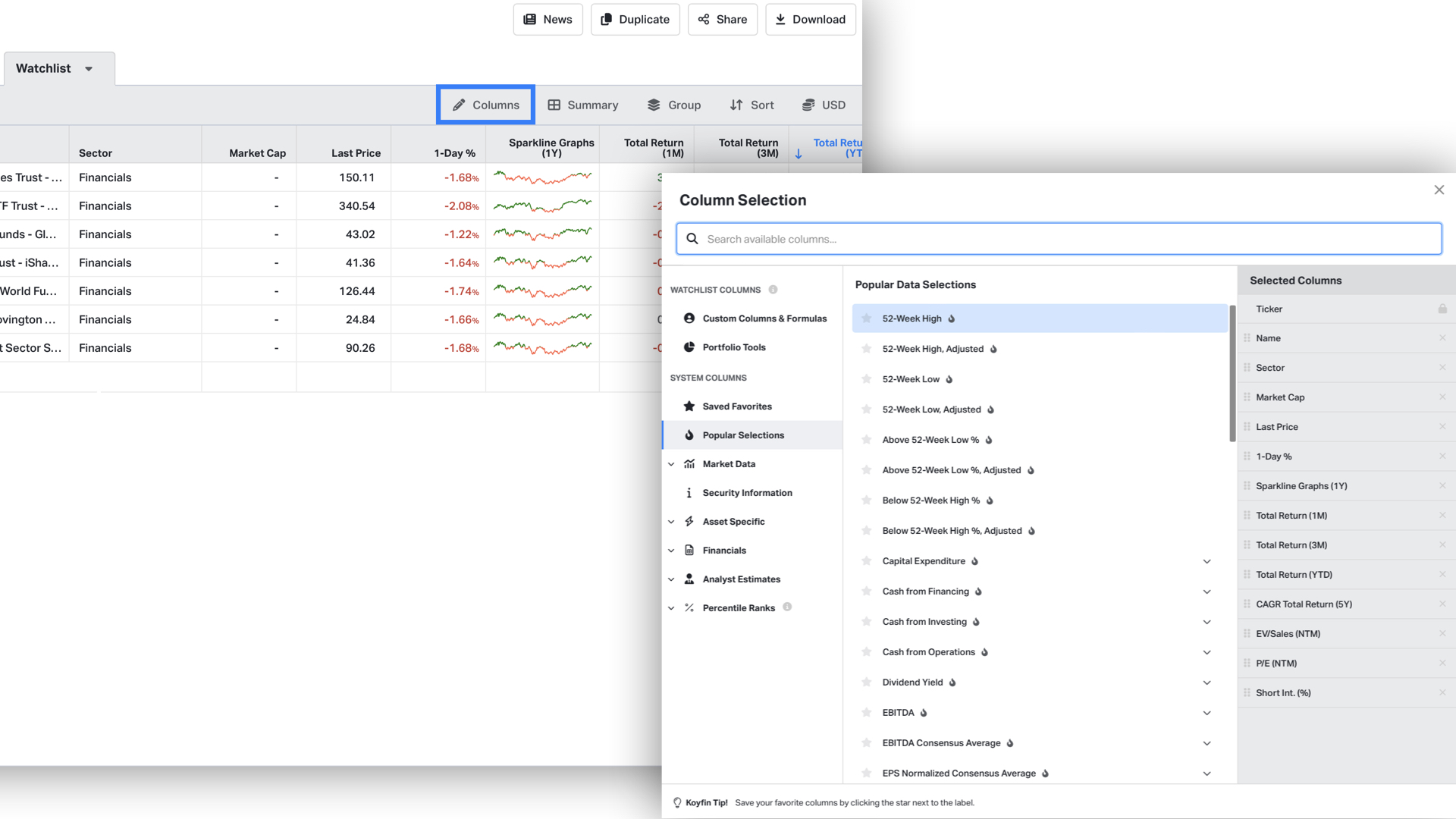Exclusivity Assets: 8 Best Luxury Brand Stocks of 2024
In the stock market, “luxury brand” companies are those that sell expensive, high-quality products. These products are often more sought after when their prices go up. These companies usually do well even when the economy isn’t, because they target wealthy customers who aren’t as sensitive to price changes. Luxury brands vary widely. True luxury brands, like Rolex or Hermes, are considered true luxury because they are exclusive and cater to rich customers. Other luxury brands are more affordable but still offer quality products. Investors might consider luxury stocks because these companies often maintain high profit margins and strong returns on capital. Many luxury brands also have long-standing histories, adding to their appeal and stability in the market.
Looking for stocks with the highest returns?
PRO TIP:
To effectively pinpoint top luxury stocks with strong investment potential, focus on these key aspects:
-
- Narrow Your Focus: True luxury stocks are fewer than often claimed. Focus on less than 30 companies globally that truly represent luxury.
- Look for True and Aspirational Brands: Select stocks from companies known for authentic luxury and aspirational appeal. These are usually the largest and most profitable in their sectors.
- Diverse Industries: While many luxury companies are in apparel, also consider those in automotive, personal care, and wine & spirits sectors for a well-rounded luxury portfolio.
*Data as of May 24th, 2024
As an investor, keeping track of the stock market is challenging due to its fast pace and data intensity. A well-crafted watchlist is crucial, enabling you to monitor stock performance, receive timely updates, and access detailed financial analytics at a glance.
Track Stock Performance: Get Analyst Ratings, Alerts, and Valuations

Ferrari (RACE)
Founded in Italy in 1947, Ferrari’s red luxury sports cars are some of the most iconic vehicles in the world. The automaker specialises in high-ticket, ultra-quality, low-volume cars, shipping just 13,200 vehicles in 2022. The company offers a range of special series, Icona, and supercars; limited edition supercars, track, and one-off cars. It also provides racing cars, spare parts, and engines, as well as after-sales, repair, maintenance, and restoration services for their models. Additionally, it licenses the Ferrari brand to various producers and retailers of luxury lifestyle goods. They also operate museums and theme parks, and provide financing and leasing services to retail clients and dealers, while running both franchised and owned Ferrari stores.
Listing on the stock market in 2015, Ferrari is one of the “younger” public companies on our list, and has proven to be a force in its short history of being publicly traded. It does have the lowest gross margin of our selections but don’t let that fool you. When compared to other automakers such as Mercedes (22%), Tesla (21%), BMW (17%) and Ford (10%), Ferrari’s 49% gross margin stands in a league of its own.
The company is expected to grow revenues by €6.52 billion in 2024 and reach €7.03 billion in sales by 2025. This is helped, in part, by their booming Chinese trade, where sales grew 97% in 2021 and a further 73% in 2022. Europe, followed by the Americas, remains their largest market, but China and the APAC region are proving to be attractive reinvestment runways for Ferrari.
Key Investment Insights for Ferrari (RACE):
Hermès (RMS)
Hermès is arguably the best example of a true luxury apparel business. Many apparel brands in the luxury sector are conglomerates that own a range from aspirational to true luxury brands. Hermès stands out in this regard, famous for its Birkin bag, which starts at an eye-watering $10,000 and can cost up to $30,000 depending on the material and size.
The company’s largest business segments are leather goods and saddlery, silk and textiles, ready-to-wear, accessories, perfumes, and watches. Founded in 1837 in Paris, France, Hermès has grown to become an international powerhouse, with its revenues primarily spread across Asia (58%), Europe (22%), and the Americas (18%). The company boasts impressive margins, holding the highest EBIT margin (42.9%) on our list. Hermès is projected to achieve double-digit revenue growth over the next three years, culminating in €18.7 billion in global sales by the end of 2026.
Key Investment Insights for Hermès (RMS):
Country | France |
Industry | Luxury Goods |
Market Cap | €229.1 billion |
Revenue (LTM) | €13.4 billion |
Gross Margin (LTM) | 72.3% |
EBIT Margin (LTM) | 42.9% |
Net Margin (LTM) | 32.1% |
P/E (NTM) | 47.1x |
Moet Hennessy - Louis Vuitton (LVMHF)
Besides being a mouthful to pronounce, Louis Vuitton Moet Hennessy (LVMH) is a powerhouse in the luxury industry. It is home to more than 75 international brands and stands as the largest luxury goods company in the world. Another company born in Paris, LVMH is run by the Arnault family and operates in wines & spirits, fashion & leather goods, perfumes & cosmetics, watches & jewelry, and selective retailing.
You may recognise several of their owned brands: Moet & Chandon, Hennessy, Belvedere, Louis Vuitton, Givenchy, Dior, Fendi, Marc Jacobs, Tiffany, Hublot, Tag Heuer, and Sephora, to name but a few. Several of LVMH’s brands have existed for more than 100 years. Part of Chairman and CEO Bernard Arnault’s vision for the company is to own legacy brands that will last for another 100 years. This sentiment was exemplified in a quote he gave to Luxe Magazine in 2015:
“I remember speaking one day to Steve Jobs about his products, and I asked him, ‘What do you think? Do you believe your phone will still be very successful in 30 years?’ He said, ‘I don’t know.’ He then asked me about my products. I replied, ‘Steve, I believe my Dom Perignon will still be enjoyed in 30 years. We are selling a piece of history.’”
LVMH is as close to a luxury ETF as investors might find, diversified across both sectors and geographies. In comparison to Hermes, LVMH is especially active in the M&A market, having recently acquired Tiffany for approximately $16 billion in 2022. As a result, some argue that a significant portion of LVMH’s projected revenue relies on inorganic growth. The company is forecasted to generate €104.03 billion in sales by 2025.
Key Investment Insights for Moet Hennessy – Louis Vuitton (LVMHF):
Country | France |
Industry | Luxury Goods |
Market Cap | €380.9 billion |
Revenue (LTM) | €86.2 billion |
Gross Margin (LTM) | 68.8% |
EBIT Margin (LTM) | 26.4% |
Net Margin (LTM) | 17.6% |
P/E (NTM) | 23.1x |
Kering (KER)
Kering SA, yet another luxury company based in Paris, is constructed in a similar fashion to LVMH in that it’s a conglomerate of global luxury brands. Kering is smaller, however, and is more concentrated in leather goods & fashion, eyewear, and jewelry. Well-known brands include Gucci, Saint Laurent, Bottega Veneta, Alexander McQueen, and Balenciaga.
A potential drawback of Kering is its reliance on Gucci, which accounts for 60% of Kering’s revenues and has struggled to generate compelling growth in recent years. The Gucci brand is also highly dependent on Asian revenues, leading some investors to perceive a greater concentration risk compared to a more diversified company like LVMH. Kering trades at a more reasonable 18.3x forward earnings multiple, but this might be because the brands in their portfolio are perceived as being of lower quality. Nevertheless, revenues are expected to grow in the coming years, with analysts predicting €20.12 billion in sales by 2025.
Key Investment Insights for Kering (KER):
Country | France |
Industry | Luxury Goods |
Market Cap | €40.8 billion |
Revenue (LTM) | €19.6 billion |
Gross Margin (LTM) | 76.3% |
EBIT Margin (LTM) | 24.3% |
Net Margin (LTM) | 15.3% |
P/E (NTM) | 18.3x |
Burberry (BRBY)
Burberry is a British brand, based in London, known for their iconic tartan pattern and trench coats. Operating under just a single brand, with a handful of sub-brands bearing the namesake of the company, Burberry’s largest driver of revenue is accessories; which accounted for 45% of retail sales in 2022. The company also sells fashion & leather goods directly to consumers, and operates smaller wholesale and licensing businesses. The Asia Pacific region accounts for 43% of Burberry’s sales, followed by Europe (33%) and the Americas (24%).
In recent years, Burberry has undergone a transformation after languishing and losing relevance. In the mid-2010s, the company set out to elevate their brand presence, and from 2022 onwards, the company promises to transform Burberry into a modern luxury brand, emphasizing its “Britishness”, global store refurbishments, and optimizing inventory prices to compete with true luxury brands. By all accounts, Burberry’s inventory offers a range from affordable to aspirational luxuries. There is a saying in the luxury industry that no company can “become” true luxury; it has to be inherent from the birth of the business. Some investors feel Burberry will stumble in this pursuit as a result.
Burberry may be considered somewhat of a turnaround story. While the margins are impressive, growth rates have been weak in recent years. The company is only expected to grow revenues to £2.9 billion by 2025, up approximately 17% from 2022. Nevertheless, this is a brand that has endured since 1856 and has shown signs of improvement in recent years. As one of the smaller market caps on this list, it might also be viewed as an acquisition target.
Key Investment Insights for Burberry (BRBY):
Country | United Kingdom |
Industry | Luxury Goods |
Market Cap | £3.8 billion |
Revenue (LTM) | £3 billion |
Gross Margin (LTM) | 67.7% |
EBIT Margin (LTM) | 14.1% |
Net Margin (LTM) | 9.1% |
P/E (NTM) | 16.7x |
Tapestry (TPR)
The parent of famous affordable luxury brands like Coach, Kate Spade, and Stuart Weitzman, Tapestry has been in the news lately due to its intention to acquire Capri Holdings for a rumoured $8.5 billion. Capri, which houses renowned brands such as Versace, Michael Kors, and Jimmy Choo, would bolster Tapestry’s portfolio upon acquisition. Currently, Tapestry is largely concentrated in the fashion & leather goods and accessories business, but this potential acquisition might herald the rise of a new titan in the luxury market.
In 2023, Tapestry generated $6.66 billion in sales, while Capri Holdings posted $5.62 billion. Combined, they would account for a $12.3 billion business. Currently, Tapestry trades at the lowest forward earnings multiple on our list, at just 9.7x NTM earnings.
Key Investment Insights for Tapestry (TPR):
Country | United States |
Industry | Luxury Goods |
Market Cap | $9.7 billion |
Revenue (LTM) | $6.7 billion |
Gross Margin (LTM) | 72.7% |
EBIT Margin (LTM) | 18.8% |
Net Margin (LTM) | 13.2% |
P/E (NTM) | 9.7x |
Moncler (MONC)
Similar to Burberry, Moncler operates under its namesake brand. They dived into the M&A market in 2020 to acquire a majority stake in Stone Island for €345 million. Founded in 1952 in Milan, they are best known for their apparel & accessories. However, in recent times, they’ve expanded into shoes, bags, glasses, and perfumes. To appeal to younger crowds, they also launched Moncler Genius.
In 2003, when Moncler was on the brink of bankruptcy, it was acquired by an Italian entrepreneur named Remo Ruffini. Ruffini transformed the company, repurposing its iconic jackets, originally made for rugged outdoor expeditions, for the luxury market. Under his leadership, Moncler transitioned from a beleaguered business with sales of less than €100 million to one projected to generate €3.2 billion in 2024. The upcoming years seem promising, with anticipated double-digit growth rates leading to sales projections of €3.6 billion by 2025.
Key Investment Insights for Moncler (MONC):
Country | Italy |
Industry | Luxury Goods |
Market Cap | €16.5 billion |
Revenue (LTM) | €3 billion |
Gross Margin (LTM) | 77.1% |
EBIT Margin (LTM) | 30% |
Net Margin (LTM) | 20.5% |
P/E (NTM) | 25x |
Estée Lauder (EL)
Estée Lauder, based in New York, is the biggest name in beauty and cosmetics, owning popular brands like MAC, Clinique, Jo Malone, Bobbi Brown, The Ordinary, and Tom Ford. Founded in 1946, EL is focused on skincare and fragrances but has more recently ventured into eyewear with the Tom Ford brand.
The luxury goods company has been undergoing a turnaround in recent years, which has been reflected in the performance of the stock in tandem. The company’s slow recovery in Asia travel retail due to travel restrictions stemming from the pandemic has been one notable area of underperformance. After a modest pandemic recovery, sales declined by 10% and gross profits by 15% in 2022, and the company issued lowered full-year guidance for 2023, which gave some investors cold feet.
Key Investment Insights for Estée Lauder (EL):
Country | United States |
Industry | Beauty Goods |
Market Cap | $45.2 billion |
Revenue (LTM) | $15.4 billion |
Gross Margin (LTM) | 70.8% |
EBIT Margin (LTM) | 8.3% |
Net Margin (LTM) | 4.2% |
P/E (NTM) | 33.1x |
How to Create a Watchlist for Top Luxury Stocks
Step 1: Sign Up to Koyfin for Free. Register an account and get started; no credit card required.
Step 2: Create a Watchlist. Head to ‘My Watchlists’, create a new watchlist and give it a name.

Step 3: Add Tickers. Click ‘Add Ticker’, then ‘Import Securities’, then copy and paste the below list of tickers.
RACE, RMS, LVMHF, KER, BRBY, TPR, MONC, EL

Step 4: Customize Columns. Hit the ‘Columns’ icon to add and remove columns from your watchlist table.
We have thousands of data points you can add to a watchlist, including fundamental data, price and returns data, analyst estimates, percentile ranks, security information, portfolio tools, and the ability to create your own formulas and labels.
Now your watchlist is ready, and you can use the rest of the Koyfin terminal to track and analyze these stocks.

FAQ
-
What is a luxury company?
A luxury company is a business that designs, produces, markets, and sells high-end, premium products or services that are often seen as status symbols or are associated with a lavish lifestyle. Examples of luxury goods include designer apparel, handbags, watches, jewelry, high-performance automobiles, yachts, and exclusive travel or hospitality experiences. Brands like Louis Vuitton, Prada, Moncler, and Ferrari are examples of entities associated with the luxury market. The appeal of luxury products often lies in their brand heritage, craftsmanship, and the aspirational value they offer. Consumers are often willing to pay a premium for luxury goods not just for their intrinsic quality, but also for the prestige and differentiation they provide.
-
Where can I find luxury stocks?
Use the Koyfin screener to find luxury stocks. Screen for the desired continent or country, pick the consumer discretionary sector and filter the industry by Textiles, Apparel, and Luxury Goods. Refine your search further with our library of other price, technical, or fundamental data series.
-
What types of products and services fall under the luxury stocks category?
Durable Goods: These are companies selling items that last over three years, like jewelry, furniture, and luxury cars.
Consumables: This category includes companies that sell products expected to last less than three years, such as high-end clothing and textiles.
Services: This includes companies that offer luxury services, such as upscale hotels and casinos.
-
Do luxury brands typically have higher profit margins than non-luxury brands?
Yes, luxury brands generally have higher profit margins than non-luxury brands due to their premium pricing. However, they also incur significant marketing costs to maintain their elite image.
-
Are there any notable trends or emerging patterns in the luxury market?
Yes, several trends are shaping the luxury market:
Digital Expansion: Luxury brands are ramping up their online platforms in response to e-commerce growth.
Eco-Focus: The push for sustainability is driving luxury brands to adopt green practices.
Targeting Youth: Adjusting strategies to appeal to millennials and Gen Z is key.
Experiences Matter: Beyond products, exclusive events and experiences are gaining traction.
Localization: Brands are tailoring products for specific regional markets.
Editorial note
Our insights are derived solely from historical information and analyst predictions, employing an impartial approach. Please note that our articles do not serve as financial guidance.








